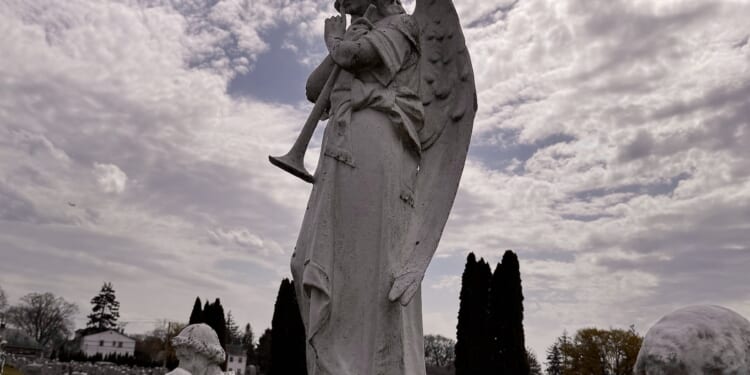Some parts of the life of Christ cannot easily be imitated, and yet good Christians find a way. We cannot literally die with Christ each day – grandma could not literally be shot once a day – and yet we can “mortify” ourselves, that is, put to death some desire, or even our own will.
Likewise, we cannot be laid in a tomb each day. And yet we must accept the humility of sleep each day. If day is like life and night is like death, then lying in one’s bed is like being laid in the tomb. And indeed, it is easy to conceive of a Christian, suffering from insomnia or early morning terrors, remaining in his bed, even though he is not sleeping, consoling himself with the thought that he is doing good nonetheless, because he is imitating Christ in the tomb.
Sometimes we imitate, or show our aspiration to be like someone, by being nearby. Thus, Mary was near her Redeemer Son at the foot of the Cross. Standing beside Him was the closest she could be. And such nearness is transitive: if I place myself beside Mary, I place myself, too, as close as I can be to the Cross. Similarly, if I place myself near to my Christian brothers and sisters in their grave, as close as I can be to their mortal remains, I place myself as close as I can be to my Lord in the tomb.
The Church began in cemeteries, the catacombs. Pilgrims to Rome figure that they must visit the catacombs there. And yet, why? Were there a greater proportion of saints buried there? Walk through any Christian cemetery today, and you are visiting the graves of many saints. Or is it that the catacombs deserve special affection because they are from “the early Church.”
But how confident are you that we are not now still in “the early Church”? I am as concerned as anyone about the apparent impending End Times. But Our Lord told us clearly that we do not know the “when.” What if in God’s providence the Church is to exist for 20,000 more years, and we right now are neglecting to visit the graves of “the early Christians”?
I can imagine few things more salutary for a family than to visit a cemetery. Sunday may be the best day for it, the “day of rest.” When others are shopping or watching games on TV, it is as if the father and mother say, “Children, this is where all of us end up. Remember that you are dust and to dust you will return. Give thought to your last end. What we most want for you is that your lives end well. We have fellowship with others in eternity. Make these the audience before whom you live your life, this ‘cloud of witnesses.’ “
And at the cemetery, it would not be inappropriate to give thanks – thanks that, in these days of cremation and scattering in which we live – someone cared enough to purchase the ground and place a stone and memorialize for centuries an immortal life lived here for only a few decades.

To give thanks, too, that, while many men have perished at sea – from drownings, or their bodies jettisoned into the deep from gang planks – these bodies here could be placed in solid ground and therefore visited. And thanks as well that while millions of men have been vaporized by artillery at war, these bodies, whole and entire – “temples of the Holy Spirit,” as we are told and believe – could lovingly be put to rest as if in a bed.
One might explain civilization by pointing to what is around a village green. The town market, the Church, a school, a civic hall, a bank. But then also: the cemetery.
It becomes a place of accounting: “These are the ones who have lived. They had their day, and they made their mark. What did they do with their portion? Did they make good use of the time allotted to them? Did they discover what is good and pass it on to us? And then what about me? My life is seen. What I have done is definite. What will it look like in the sight of others, when it too is over and taken into account?”
The Church, through its maternal granting of indulgences, teaches us to visit cemeteries. From November 1 through November 8, you and I may obtain one plenary indulgence each day, which is applied to a soul in Purgatory – that is to say, that soul most definitely leaves Purgatory and enters Heaven – if we visit a cemetery and pray there for the dead. (The other days of the year, the indulgence is partial, not plenary.)
Of course, we must fulfill the usual conditions for the granting of an indulgence: a whole-hearted detachment from all sin, prayer for the intentions of the Holy Father, and, within a reasonable time (one to two weeks before or after), making a sacramental Confession and receiving Communion.
The word “cemetery” means “place for sleeping” (from the Greek verb for sleeping, koimaō). It was never applied to pagan graveyards, but rather coined specifically for the graveyards of Christians and Jews who believed in the resurrection of the dead.
We must learn to see Christian “sleeping places” in this way. They must come to appear to us in a certain way. They are not dreary places of hopelessness and annihilation. – “She is not dead, but sleeping.” (Luke 8:52)
Rather, they are places of anticipation, of assurance of the quick passing of this world. The bodies there, the remains, are as if longing to be called from their tombs, like Lazarus.
A cemetery is a holy place, an extension of a church, the hard-won ground of many battles, a democracy of the Christian dead, a nexus of reckoning, and a rebuke and affront (“Let me go back and warn my brothers” Luke 16:28). To a pagan it is merely spooky; to a Christian, it is a visible and tangible mystery.




![Hegseth Demands Fitness Requirements, Says 'Fat Troops' 'Not Who We Are' [WATCH]](https://teamredvictory.com/wp-content/uploads/2025/09/Hegseth-Demands-Fitness-Requirements-Says-Fat-Troops-Not-Who-We-350x250.jpg)






